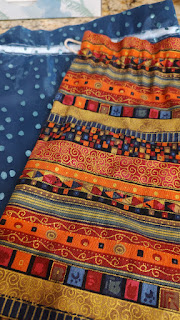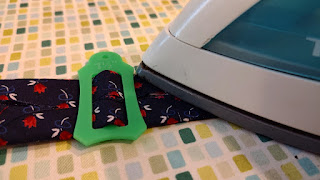I am not generally a purse person. I use them to carry my stuff, but I don't have many. I use a relatively small crossbody purse daily, and the zipper on that bag broke. The bag was a little smaller than I needed and the fabric had pilled. Instead of taking apart the purse to replace the zipper, I decided it was time for a new purse.
Through an online search, I identified a cross-body purse pattern that filled my needs - the Teya Crossbody from Apple Green Cottages. I downloaded the pattern and printed it on recycled paper. Then I began searching through my stash of materials.
I had wanted to use the upholstery scrap with the blue flower (pictured above) forever and decided to coordinate that with a plain blue scrap I had a bunch of zippers from the jumble stash. I also had a strap and hardware from a purse that was still functional, but really dirty despite washing. I also had some lightweight interfacing, quilting cotton, corduroy, and a jacket that my son had outgrown, but was not in good enough shape to be given away.
Upcycling means working with what I have, not necessarily what the pattern envisioned and I had several redos and adaptations along the way.
I had hoped to use the jacket for the pocket linings at the front and back of the purse, thinking it would add water repellency, but when I pinned the pattern pieces to the fabric and cut one of the pocket linings, I realized that I did not have enough and it wasn't sturdy enough for what I needed. I switched to the quilting cotton I was using on the pattern.
The upholstery scraps also caused me consternation. One of the first steps of the pattern was to make a tab for a recessed zippered. The directions called for the fabric to be folded over twice. I tried that with the flowered upholstery and with the plain upholstery and both fabrics were simply too thick. I ended up cutting the tab to nearly the size I wanted and using an overcast stitch and some fray check to finish the edges.
The seam allowance on the bag was 3/8 inch and in some places, I simply went to 1/2 inch to accommodate the thickness of the layers. The bottom of the bag is not as neat and crisp as I would have liked, but I hope no one is looking at that too carefully. The pattern called for the strap ends to be sewn onto the side seam on the outside. The fabric was too thick to sew there so I moved it to the inside on the top edge.
I made a few changes that went off without a hitch I did not have any fusible fleece so I sewed the corduroy to the bag lining. None of the zippers were exactly the right size. With pliers and an Xcato knife, I was able to cut down the top metal zipper. The other two zippers were an inch smaller than called for. One required no modification and the other required me to lengthen by 1/2 inch the fabric tabs on either side of it. I was able to add clips to the inside and outside of the purse.
I haven't yet tackled water repellency and I am not yet sure if I will do that, but I did test rubbing some beeswax on some of the outer fabric after warming it with an iron and I may add that later (probably by melting it and brushing the wax on)
I am looking forward to transferring my stuff to this bag tomorrow and seeing how this works in real life.











































%20v3.png)
%20v3.png)
